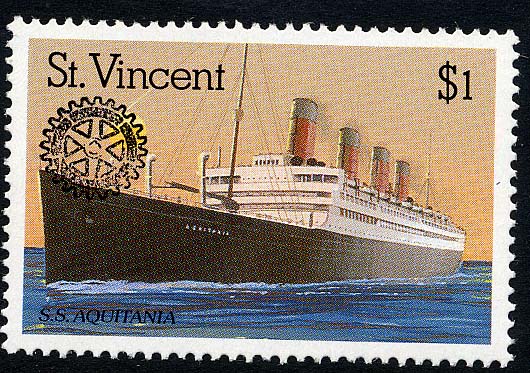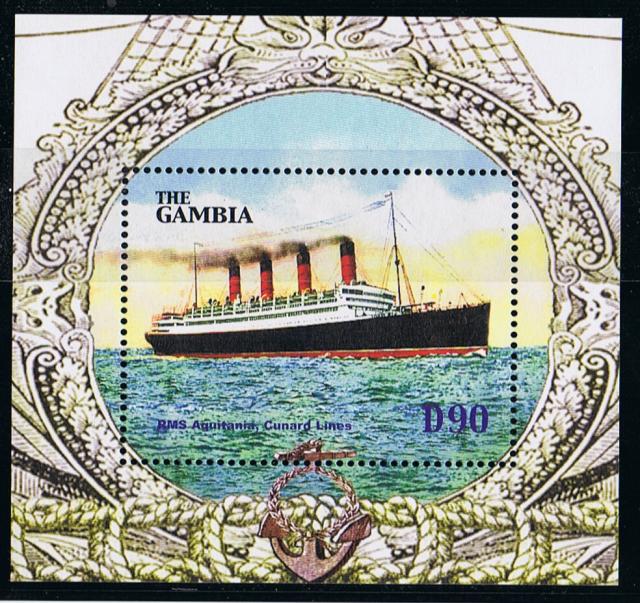

The Aquitania was designed for the North Atlantic mail and passenger service and to operate with the Lusitania and Mauretania of 1907. Their high speed earned them an annual subsidy; in the planning which lay behind the Aquitania the aim was to create a ship which would earn as much without a subsidy as the others did with one. The service speed aimed at was 23-231/2 knots, which was sufficient to sail from either terminal at three-weekly intervals. In the event, she proved able, in later years, to maintain a fortnightly schedule. In terms of speed she was thus superior to the White Star Olympic and broadly comparable to the Hamburg-American Line's Imperator. The White Star Olympic class ships were the last of the giant liners to have triple screws and combination machinery while the Aquitania was the last British-built one to have direct-drive turbines. She was also the last four-funnelled liner to enter the North Atlantic trade; with her withdrawal in 1949 four funnels disappeared from the North Atlantic scene.
Seen in relation to her length, and the lengths of the Olympic and Imperator, her gross tonnage-45,647—was somewhat low. Her displacement was approximately 53,000 tons and load draught 36 ft 2 in. Her hull weighed approximately 29,150 tons and her machinery 9,000 tons. The overall length was 905 ft (865 ft b.p.), breadth mld 97 ft, and depth mld 64 ft 6 in. The Aquitania had quadruple screws and these were driven by Parsons direct-drive turbines, there being one H.P., one intermediate and two L.P. units, also an astern turbine on each shaft. The L.P. ahead turbines actuated the two inner shafts, while the H.P. and intermediate-pressure ahead turbines operated the outer ones. The designed i.h.p. was 60,000. Steam at 195 p.s.i. was provided by 21 double-ended (Scotch) boilers. Judged by present standards the length of hull occupied by the boiler rooms and bunker space was tremendous. It extended from a point midway between the foremast and the bridge to the after side of the fourth funnel. Yet the turbines compartment, the next astern, ended before the after edge of the main superstructure. The top of the boiler rooms approximated to the waterline. Above, there were five decks in the hull and three in the superstructure. Forward, there were two holds, with C to H decks above. Other special features were a large internal swimming pool, Frahm anti-rolling tanks and a rudder/stern shape which resembled those of the Lusitania and Mauretania but was quite different from that of the Olympic. Unlike hers, the rudder was of balanced type and completely submerged.
As built, the Aquitania was fitted to carry 618 first-, 614 second- and 1,998 third-class passengers. The crew numbered about 970. Officers' accommodation excepted, the whole of the main superstructure was devoted to the first-class. Down one deck, at a point beneath the two forward funnels, there was also the first-class entrance foyer. Just forward of this, there was the lowest block of first-class cabins and, aft of it, the great first-class dining saloon. The second-class occupied the after superstructure. Most of the third-class was also aft, but at a lower level, with some forward.
The Aquitania was built and engined by John Brown & Co. Ltd. and launched at Clydebank on 21 April, 1913. At the end of May 1914 she left Liverpool on her maiden voyage to New York and made three round trips before the declaration of war. On 8 August, armed with some 6 in. guns, she left the Mersey on her first patrol as an auxiliary cruiser. Later she was more sensibly used as a troopship and hospital ship and served in the Dardanelles campaign. In 1919 she made some commercial voyages to the States, but in November she commenced a 7-month refit on the Tyne. During this she was converted to oil-burning and given a bunker capacity of 7,000 tons, sufficient for a round voyage and more.
She then commenced the main period of her North Atlantic career, operating between Southampton, Cherbourg and New York with the Mauretania and Berengaria. During the Second World War she again became a troopship. Mainly used to carry U.S. servicemen across the Atlantic, she also travelled as far afield as Australia and Pearl Harbour. In 1948 she was returned to the Cunard and, after making 25 voyages to Halifax with settlers, she was sold to the British Iron and Steel Corporation and in 195o was scrapped at Faslane on the Firth of Clyde.
St Vincent SG1225, Gambia SG?
Merchant Ships of the World
